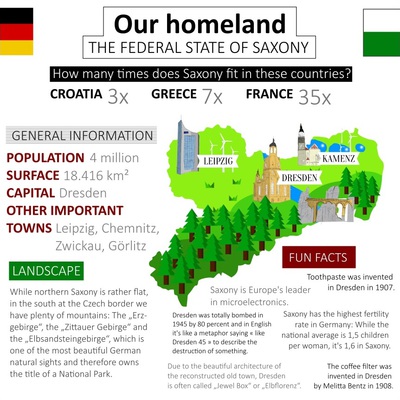
Kamenz
Kamenz is located in a multifaceted region, with small towns, big cultural centres like Dresden and Görlitz, hills and flat country with some lakes, some of them are artificial.
The town where our school is is named after the Sorbian word „Kamjenc” which means „small town at a stone”. It has round about 12,000 inhabitants. The most important sight is the old town centre.
You might start your tour through Kamenz at the market square. The town hall with its red tower is located here. The traditional centre of Kamenz is full of old buildings, and the St. Andrew's fountain is here. The Western Lusatia Museum might be a nice attraction for history and biology lovers as it gives many informations on the local past and nature. Various restaurants in Kamenz let cuisine lovers get their money's worth.
In Thessaloniki, you have the Λευκός πύργος (White tower), but our tower in Kamenz is even coloured, in fact red (Roter Turm). It's 32m high and served for the defence of Kamenz as a part of the city wall. Afterwards, it was used as a prison for noblemen.
The St. Mary's church is probably the biggest sight of Kamenz and its tower can be seen from even far away, it's the symbol of Kamenz. Many architectural styles are mixed in the church, from medieval times to gothic. If you climb the tower, you will have great views onto Kamenz and the nearby landscape.
The hill of Kamenz is named Hutberg. It serves for nice walks. On it the Lessing Tower is located, surrounded by hundreds of rhododendrons which is extra nice in spring when the rhododendrons are in flower. On top of the hill is also the „Hutbergbühne“(Hutberg stage), used for various events such as concerts.
Taking the train, you'll only need 40 minutes and you will be in the Saxonian capital, Dresden. It is also a cultural centre and a famous destination for tourism. It lies at the river Elbe which divides the city into two parts. Walking around in the old town city centre is a unique experience. The undisputable main attraction is the church “Frauenkirche”, which was completely destroyed in World War II by the allies' bombing and was left to it's own devices later. After 1990, the church was rebuilt in all its glory, as a symbol for conciliation, peace and the German unity. The close-by Elbe valley and the Sandstone Mountains are inviting for nice day trips.